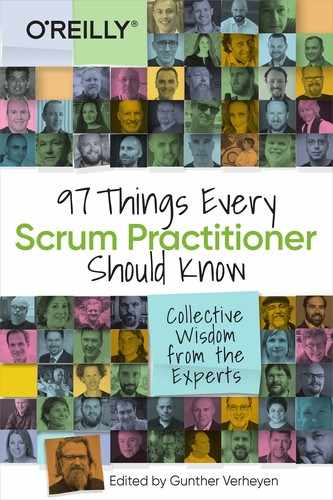Chapter 92. Scrum: Problem-Solving and the Scientific Method in Practice
Si Alhir

“What is Scrum?” is a quintessential question that deserves a quintessential answer.
Scrum is the fusion of problem-solving in the macro and the scientific method in the micro for working in a complex space. Scrum establishes a framework that fuses problem-solving and the scientific method, with its roles, events, and artifacts, and the rules that bind them for operating in a complex environment, doing complex work, and generating complex results.
Complexity exists where there is a gap between cause and effect—that is, a context where there is a gap between cause and effect in the environment, the work, or the results. There may be unknowns in the environment, in the nature of the work itself, or in the resulting solutions, and these unknowns are only revealed during the work, while enacting problem-solving combined with the scientific method.
The essence of problem-solving is discovering, defining, developing, and delivering a solution to a problem. The essence of the scientific method is experimentation. When combined, the fusion of problem-solving and the scientific method is about performing experiments to realize a solution to a problem and confronting the gaps.
Enacting problem-solving and the scientific method involves Actions, Intentions, and Results (AIR). Nothing will be achieved without Actions. No direction is taken without Intentions. And Results are the outcome of Intentions and Actions.
Allow me to express Scrum through the lens of AIR.
To confront complexity, a Result Owner, Action Team, and Dynamics Owner partner to achieve success in realizing a valuable solution to a problem through experimentation.
The Result Owner champions a Result by engaging the Action Team in discovering and defining a Result of value. Intentions express the intended Result. There is a list of all the Intentions needed in the Result. The Result is the actual realization of Intentions. Essentially, Intentions express a solution to a problem, and a Result is the actual solution.
An Action Team champions Actions by engaging the Result Owner in developing and delivering a Result of value. Actions express how a Result is realized based on the Intentions. The Action Team chooses how best to realize the Result—that is, the team is self-organizing. The Action Team has all the competencies needed to realize the Result—that is, the team is cross-functional. Essentially, experiments are expressed through Actions.
A Dynamics Owner champions the dynamics between the Result Owner, Action Team, and the context in which they operate. The Result Owner and Action Team flow together and pull on one another, and the Dynamics Owner works with the Result Owner, Action Team, and the context to ensure progress toward success.
Events create regularity among the Result Owner and Action Team. An overarching, time-boxed event serves as a container—a bounded window of time—to shift everyone’s focus toward achieving a goal. Each time-box opens with a planning event to launch it, has routine touchpoint events to ensure synchronization, and closes with a review event to demonstrate progress and a retrospective event to improve.
The answer to “What is Scrum?” is more fascinating than calling Scrum just another delivery process. Scrum is the fusion of problem-solving and the scientific method tuned for navigating the complex world. Scrum defines a Result Owner, Action Team, Dynamics Owner, Intention Backlog with Intentions, Action Backlog with Actions, Result, and the events and rules that bind them together.
